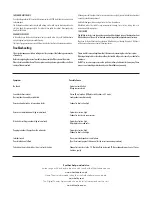
Home Theatre Guidelines
SETTING LOUDSPEAKER SIZES
Always choose 'Small' for the Surround channels and
Centre channel whether you are using a subwoofer or not.
If you are
using a subwoofer:
If you
using a subwoofer:
SETTING LEVELS
DELAY SETTINGS
Rear Delay:
Centre Delay:
PHASE
SUBWOOFER MAINS OPERATION
Many digital AV Processors require you to specify the size of
speakers in all channels. These are usually ‘Large’ or ‘Small’.
Set the Front Speakers to
‘Large’. Set the ‘Subwoofer’ option on the processor to 'Off' or
'No'. The Front channels will now receive all the system bass.
If you set the speakers to
‘Small’ the low bass content of the front channels will be
directed to the subwoofer, along with the bass from the Rear
and Centre Channels. In other words all the system bass will go
into the subwoofer. If you choose ‘Large’ the Front channel
bass will be reproduced from the Front speakers. Bookshelf
speakers (Zaldek 300) should be set to ‘Small’, large floor
standing units (Zaldek 2000) may be set to ‘Large’.
Refer to your AV processor handbook for detailed guidance.
Once the loudspeaker settings have been finalised, put the AV
amplifier into its “Test” mode (see instructions supplied with
your processor). Adjust the level of each channel in turn until all
channels are reproduced at equal loudness.
NOTE: On some programme material the surround channel may
seem lower than the front. Do not readjust this level.
You may, however, need to adjust the subwoofer output level.
Avoid setting too high a level or you will swamp the sound with
bass which be tiring to listen to and may limit the subwoofer’s
ability to respond to large bass transients. Set a sensible level
going into the subwoofer from the AV processor. The volume
control on the subwoofer should be between 12 o’clock and 3
o’clock when the system as a whole is playing moderately loud.
Many AV processors feature delay settings. The purpose of delay
is to enable surround and dialogue information to arrive at the
listener’s ears at the same time as the Front channels, even
when the listening seat is in a non-ideal position.
If the listening position is equidistant from the
Front and Rear speakers, the delay should be set to a low
setting. If the listener is closer to the Rear speakers the delay
settings should be increased; the further away the listener is
from the front speakers, the higher will be the setting needed.
If the Centre loudspeaker is level with (or
slightly behind) the Front speakers, set the delay to minimum.
If the Centre speaker is forward of the Front speakers increase
the delay.
In the cinema the Low Frequency Effects channel is an
bass channel with its own dedicated subwoofer and
a regular subwoofer channel. In domestic Home Theatre
systems the LFE channel typically feeds into the subwoofer.
Where no subwoofer is used, the LFE signal is combined with
Front Channel information. When you set the LFE level at your
AV processor, use care as the LFE channel may contain powerful
low frequencies which can overload a domestic loudspeaker.
If you hear popping or thumping noises coming from the front
loudspeakers or subwoofer, immediately turn the AV Processor's
volume level down and then back off the LFE level. This should
cure the problem. If it does not, back off the volume level at the
subwoofer (if you are using one) until the problem disappears.
Please read the relevant sections of your AV amplifier manual
and familiarise yourself with the various issues. If you are
unsure, consult your dealer for help.
A correctly connected Home Theatre system has a precise front
stage, a diffuse rear stage and good localisation of dialogue
which should appear from the mouths of the actors. If the
colours on the loudspeaker terminals do not correspond with
those on the amplifier, the sound will appear poorly focussed or
‘out of phase’. For this reason it is extremely important that the
speakers are connected strictly in accordance with the wiring
diagrams in this manua
We recommended that you switch off the Zaldek sub bass unit
when the system is not in use, to protect it from switching noises
from domestic appliances, etc. The auto switch off is adequate
for short periods but if the system is not to be used for some
time - switch it off.
Switching the complete system from a central point will avoid
you having to switch on the subwoofer when you want to play
the system. Remember to turn the main volume control to
minimum whenever you switch the equipment on or off.
not
are
LFE
additional
not
l.
FRONT CHANNELS
REAR CHANNELS
CENTRE CHANNEL
SUBWOOFER
The front channel loudspeakers are placed on either side of the
television screen, 2 to 3 metres apart. The speakers should be
angled slightly so they are aimed towards the listeners.
As these are the ‘effects’ channels the reproduced sound should
be as room filling as possible. To aid this we recommend placing
the speakers in a high position, slightly behind the listener’s
head. Angled towards the listener and positioned high, the rear
speakers give a good rear perspective combined with a diffused
sound field. Two possible placements are indicated in the
diagrams.
Note: If the rear wall is more than 1 metre behind the listening
seat, position the units on the side walls. If the side or rear walls
are inconveniently located, you could consider stand mounting
the loudspeakers.
Most of the dialogue comes from the centre loudspeaker. This
ensures that the speech appears to originate from the actors’
mouths, not displaced to either side.
The operating height of the speakers is important. For best
results the front and centre channel speakers should be
operated at the same height if possible. For this reason the
centre channel speaker should be operated on top of the
television monitor. Placing the centre loudspeaker under the
television screen is definitely second best.
Ideally the front faces of the centre and surround loudspeakers
should be in line though this may not be practicable in all cases.
As the ear is unable to detect the direction from which deep bass
originates, this allows freedom in positioning the subwoofer.
Varying the distance from the wall will alter the amount of bass,
the level increasing as the unit is moved closer to the wall. Some
prefer to place the subwoofer against a corner of the room. This
arrangement gives more bass at the possible expense of clarity.
Remember to place the subwoofer no closer than 450mm from
the television screen or you may cause distortion in the picture.
System using Zaldek Surround speakers
System using conventional rear speakers
The Home Theatre Environment
CHOOSING FRONT AND REAR CHANNEL LOUDSPEAKERS
Consider carefully your choice of Front loudspeakers, especially if you are
not going to use a separate powered sub bass unit. Alhough the Zaldek
300 and 600 will perform well as front loudspeakers especially in a
smaller system, we would advise you to consider one of the larger floor
standing units, especially if you own a Digital processor.
You may use any regular loudspeakers in the Zaldek series for the Rear
channels but we strongly recommend that you use the specially designed
Zaldek Surround loudspeaker. If you
use conventional units, this is
perhaps best accomplished with a pair of bookshelf models placed on
high stands or wall mounted on suitable swivel brackets.
do
The ‘voicing’ of each Zaldek loudspeaker has been designed to match the
others - there is a sonic identity across all the models in the range.
Dispersion characteristics have also been taken into account. The result is
a range of versatile loudspeakers that can be used for traditional Stereo
reproduction but are equally at home in Home Theatre applications.
FRONT
LEFT
FRONT
RIGHT
Zaldek
SUB
BASS
REAR
RIGHT
REAR
LEFT
CENTRE
REAR
RIGHT
REAR
LEFT
FRONT
LEFT
FRONT
RIGHT
Zaldek
SUB
BASS
CENTRE
FRONT
RIGHT
FRONT
LEFT
Zaldek
SUB
BASS
CENTRE
REAR
RIGHT
REAR
LEFT
ALTERNATIVE
POSITIONS
ALTERNATIVE
POSITIONS
4


























